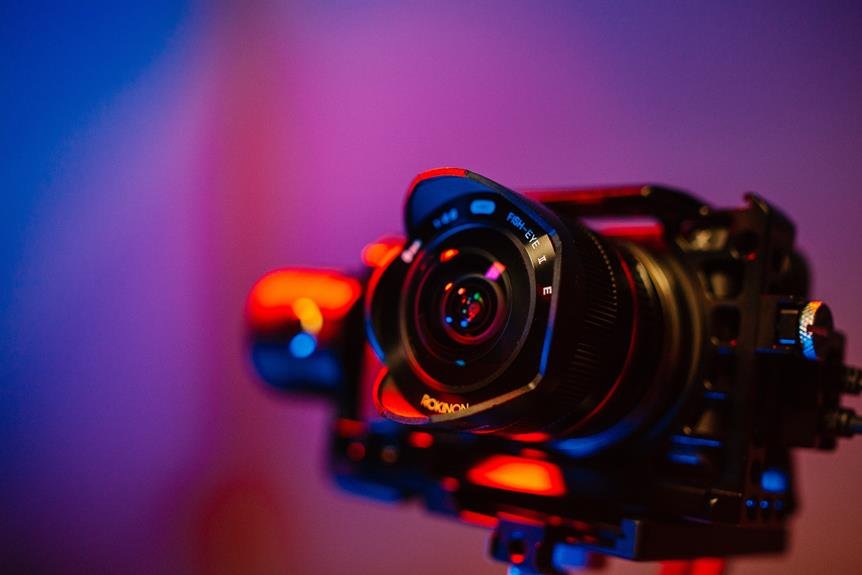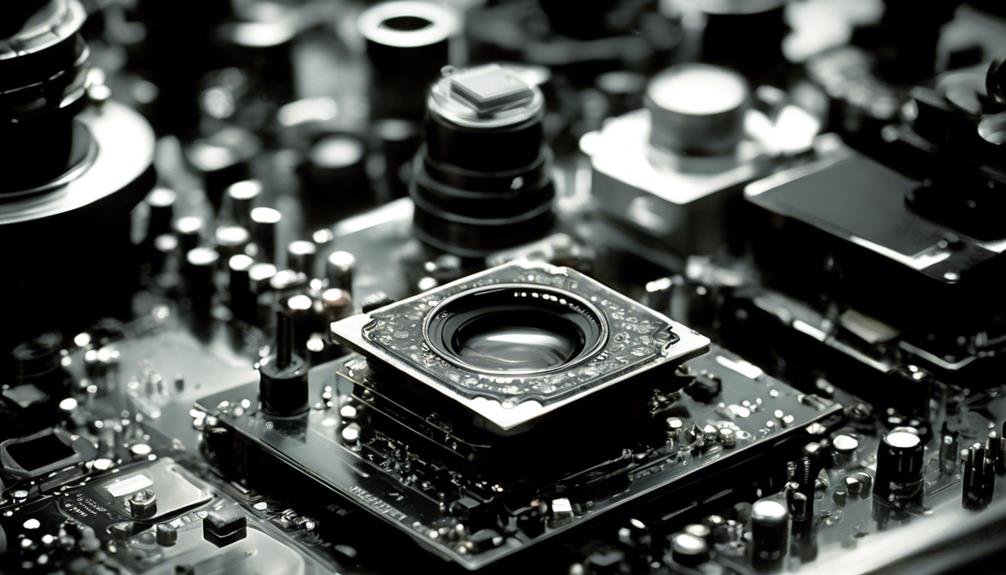
We've seen a remarkable 8% year-over-year increase in sensor resolution across mirrorless cameras, indicating a significant trend towards higher pixel counts. But what exactly compels this constant push for sensor upgrades in mirrorless cameras? The reasons go far beyond mere pixel peeping. As we delve into the driving forces behind the evolution of mirrorless camera sensors, we uncover a landscape shaped by the demands of high-resolution imaging, improving low-light performance, advancements in dynamic range, and the ever-growing need to enhance autofocus capabilities.
Evolution of Sensor Technology
In recent years, sensor technology in mirrorless cameras has undergone significant advancements, driving improvements in image quality and overall performance. One of the key factors contributing to these advancements is the evolution of sensor size and pixel density. As sensor sizes increase, they allow for more light to be captured, resulting in improved low-light performance and dynamic range. Additionally, higher pixel density enables sharper images with finer details, enhancing the overall image quality.
The shift towards larger sensor sizes, such as full-frame and medium format, has become increasingly prevalent in the mirrorless camera market. These larger sensors offer advantages in terms of improved depth of field control and better high ISO performance. Furthermore, advancements in pixel density have led to sensors with higher megapixel counts, allowing for larger prints and more flexibility in post-processing.
As sensor technology continues to evolve, we anticipate further improvements in sensor size and pixel density, ultimately leading to even higher image quality and performance in mirrorless cameras. These advancements are crucial for meeting the demands of photographers and videographers who seek innovation and excellence in their imaging tools.
Demands of High-Resolution Imaging
The evolution of sensor size and pixel density in mirrorless cameras has directly influenced the demands of high-resolution imaging, shaping the expectations for enhanced image quality and finer details. As high-resolution imaging becomes increasingly sought after, the need for sensors with high pixel counts and exceptional color accuracy has intensified. High pixel count allows for greater detail and clarity in images, while accurate color representation is crucial for producing true-to-life visuals.
| High-Resolution Imaging Demands | |
|---|---|
| High Pixel Count | Enables capture of finer details and improved image sharpness. |
| Color Accuracy | Essential for producing true-to-life and vibrant images. |
| Enhanced Image Quality | Demands for sharper, more detailed, and true-to-life visuals. |
| Greater Color Depth | Enables the representation of a wider range of colors and tones. |
| Improved Low-Light Performance | Enhanced sensor capabilities for better performance in low-light conditions. |
The demands of high-resolution imaging are driving sensor technology to continually advance, meeting the increasing expectations of photographers and videographers for superior image quality, precision, and fidelity.
Improving Low-Light Performance

Significant advancements in sensor technology have markedly enhanced low-light performance in mirrorless cameras, ensuring superior image quality even in challenging lighting conditions.
- Low Light Sensitivity: Modern mirrorless camera sensors are designed to have higher sensitivity to light, allowing for better image capture in low-light conditions. This is achieved through improved pixel design and layout, as well as enhanced signal processing capabilities.
- Noise Reduction: Advanced noise reduction algorithms and technologies have been integrated into the sensors of mirrorless cameras. These technologies effectively reduce the presence of noise in low-light images, resulting in cleaner and more detailed photographs even in dimly lit environments.
- Wider Dynamic Range: Sensor upgrades have led to an expanded dynamic range, enabling mirrorless cameras to capture a broader range of tonal values in low-light settings. This improvement allows for better retention of details in both highlight and shadow areas, contributing to overall image quality in challenging lighting conditions.
These advancements in low-light performance have significantly improved the capabilities of mirrorless cameras, providing photographers with the tools to capture high-quality images in a variety of lighting situations.
Advancements in Dynamic Range
Advancements in dynamic range technology have revolutionized the image capture capabilities of modern mirrorless cameras, building upon the enhanced low-light performance to deliver even greater tonal details and image fidelity. Sensor design plays a pivotal role in expanding dynamic range capabilities. By implementing advanced sensor designs, such as backside-illuminated (BSI) sensors, manufacturers have been able to significantly improve the signal-to-noise ratio, leading to better dynamic range and reduced noise levels. Moreover, noise reduction algorithms have seen substantial improvements, further enhancing the dynamic range by effectively mitigating noise in high-ISO images. Additionally, the correlation between sensor size and dynamic range cannot be overlooked. Larger sensors inherently offer improved dynamic range, allowing for better color accuracy and tonal gradation, especially in challenging lighting conditions. This progress in sensor design and noise reduction has contributed to a notable enhancement in color accuracy, empowering photographers to capture scenes with remarkable fidelity and detail.
| Sensor Design | Noise Reduction | Color Accuracy |
|---|---|---|
| BSI Sensors | Advanced Algorithms | Enhanced Fidelity |
| Larger Sensor Size | High-ISO Performance | Improved Tonal Gradation |
Enhancing Autofocus Capabilities

With improved sensor technology and precision engineering, mirrorless cameras are experiencing a notable enhancement in autofocus capabilities. This advancement is driven by the integration of cutting-edge depth perception and image processing algorithms, resulting in faster and more accurate tracking speeds. The following factors are instrumental in the continuous improvement of autofocus capabilities in mirrorless cameras:
- Depth Perception: Advanced sensor technology enables enhanced depth perception, allowing cameras to more accurately assess the distance to subjects. This depth information is crucial for precise autofocus, especially in scenarios with multiple subjects or complex foreground-background relationships.
- Image Processing: The utilization of sophisticated image processing algorithms plays a pivotal role in refining autofocus capabilities. These algorithms analyze the visual data from the sensor, enabling the camera to swiftly and accurately adjust focus based on the scene's characteristics.
- Tracking Speed and Accuracy: The combination of improved sensor technology and refined image processing contributes to notable enhancements in autofocus tracking speed and accuracy. This is particularly beneficial in dynamic shooting situations where swift and precise autofocus adjustments are essential for capturing sharp, clear images.
The evolution of autofocus capabilities in mirrorless cameras underscores the industry's commitment to innovation and continuous improvement in meeting the demands of photographers and videographers.
Frequently Asked Questions
How Does the Upgrade of Mirrorless Camera Sensors Impact the Overall Size and Weight of the Camera?
When mirrorless camera sensors are upgraded, there is a tangible impact on the overall size and weight of the camera. These upgrades lead to size reduction and weight reduction, enhancing portability and user experience.
What Role Do New Sensor Technologies Play in Reducing Noise and Improving Image Quality in Mirrorless Cameras?
New sensor technologies revolutionize low light performance, dynamic range, and image processing in mirrorless cameras. The compact sensor size belies its power, delivering unparalleled image quality. It's truly a game-changer, transforming how we capture the world.
Are There Any Specific Challenges That Arise When Upgrading Sensor Technology in Mirrorless Cameras Compared to Traditional Dslrs?
Challenges in upgrading sensor technology for mirrorless cameras, compared to traditional DSLRs, include managing sensor size, weight, and their impact on image quality. These factors drive the need for continuous innovation in sensor development.
How Do Advancements in Sensor Technology Affect the Energy Efficiency and Battery Life of Mirrorless Cameras?
Advancements in sensor technology significantly impact energy efficiency and battery life in mirrorless cameras. New sensors can improve energy consumption by up to 30%, extending battery life for longer shooting sessions, enhancing user experience.
Can the Upgrade of Mirrorless Camera Sensors Lead to Changes in the Lens Mount or Compatibility With Existing Lenses?
The upgrade of mirrorless camera sensors can impact the lens mount and compatibility with existing lenses. Advancements in sensor technology may necessitate changes to the lens mount system to accommodate improved sensor capabilities and optimize compatibility with existing lenses.
